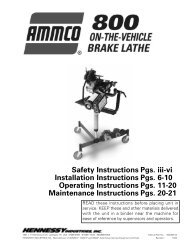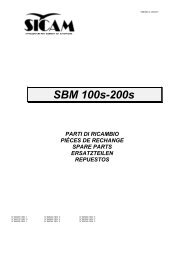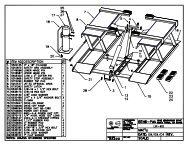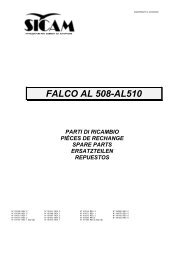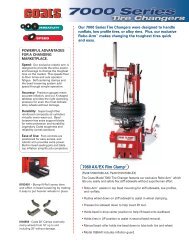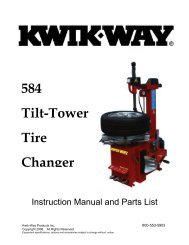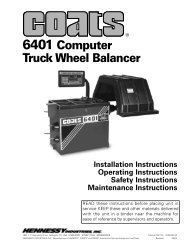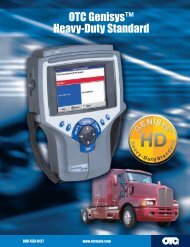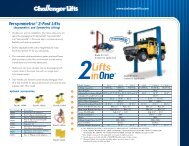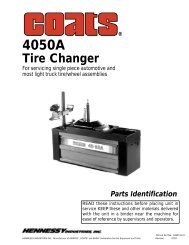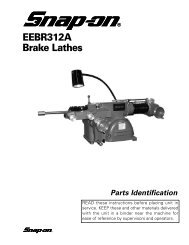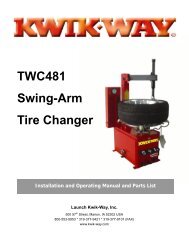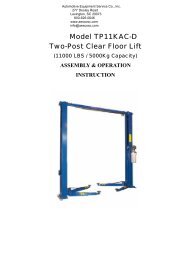150/250 Wheel Balancer - aesco
150/250 Wheel Balancer - aesco
150/250 Wheel Balancer - aesco
You also want an ePaper? Increase the reach of your titles
YUMPU automatically turns print PDFs into web optimized ePapers that Google loves.
<strong>150</strong>/<strong>250</strong> <strong>Wheel</strong> <strong>Balancer</strong>BASIC MACHINE CALIBRATION (continued)‣ Run a balancing cycle.‣ At the end of the run C-4 will appear on the left display and 100 or 3.50 on the right. Rotatethe tire and wheel until the weight is at the 12:00 o’clock position, then remove and reattachthe weight to outside flange exactly at the 12:00 o’clock position.‣ Run a balancing cycle.‣ C-5 will appear in the left display and the calibration angle in the right, rotate the tire andwheel until the wheel weight is exactly in the 6:00 o’clock position.‣ While holding the wheel in this position, press the Split weight button. Figure 6 (13).The calibration settings are automatically and permanently saved.Two test procedures are necessary to ensure that wheel balancing is conducted accurately.Balancing Accuracy Test:‣ Balance the two sides of a wheel according to the instructions.‣ Artificially create an imbalance by fitting a weight of 50 grams (1.75 ounces) on one side ofthe wheel. The machine should identify this imbalance precisely, both for weight andposition. A reading up to a maximum of 5 g (.25 ounce) is possible for the other side.‣ In order to check the position of the imbalance, turn the wheel to the balancing position asindicated by the arrows on the monitor. In this position the test weight should be verticallybelow the rotation axle (6 o’clock).‣ If there is an obvious angular error the indicators have to be rectified.‣ If there is an unacceptably big weight error on the side with the test weight, or an excessivefigure for the opposite side of the wheel, the machine has to be recalibrated.Centering Precision (Balancing Quality):‣ The wheel balanced in the previous test can be used. Remove the test weight. Release thewheel from the adapter and retighten it, but rotated by about 35°.‣ In a test cycle the imbalance must not exceed a maximum of 10 g (.5 ounce) on each side,15 g (.75 ounce) in the case of particularly heavy wheels. This error is due to the rimcentering tolerance.‣ Precise centering is essential both for this test and during normal balancing operations. Ifthis test run produces a high imbalance reading check the parts used for centering thewheel for wear, play, and dirt.Kwik-Way Products Inc. 23. 800-553-5953500 57 th Street, Marion, IA 52302 USACopyright 2005 All Rights ReservedEquipment specifications, options and accessories subject to change without notice.



